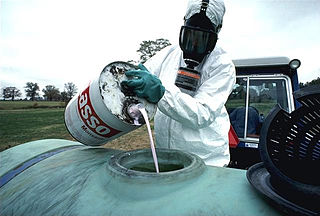
Pesticides are substances that are meant to control pests. The term pesticide includes all of the following: herbicide, insecticides nematicide, molluscicide, piscicide, avicide, rodenticide, bactericide, insect repellent, animal repellent, antimicrobial, and fungicide. The most common of these are herbicides which account for approximately 80% of all pesticide use. Most pesticides are intended to serve as plant protection products, which in general, protect plants from weeds, fungi, or insects. As an example - The fungus Alternaria is used to combat the Aquatic weed, Salvinia.

Herbicides, also commonly known as weedkillers, are substances used to control unwanted plants. Selective herbicides control specific weed species, while leaving the desired crop relatively unharmed, while non-selective herbicides can be used to clear waste ground, industrial and construction sites, railways and railway embankments as they kill all plant material with which they come into contact. Apart from selective/non-selective, other important distinctions include persistence, means of uptake, and mechanism of action. Historically, products such as common salt and other metal salts were used as herbicides, however these have gradually fallen out of favor and in some countries a number of these are banned due to their persistence in soil, and toxicity and groundwater contamination concerns. Herbicides have also been used in warfare and conflict.

Insecticides are substances used to kill insects. They include ovicides and larvicides used against insect eggs and larvae, respectively. Insecticides are used in agriculture, medicine, industry and by consumers. Insecticides are claimed to be a major factor behind the increase in the 20th-century's agricultural productivity. Nearly all insecticides have the potential to significantly alter ecosystems; many are toxic to humans and/or animals; some become concentrated as they spread along the food chain.
Under United States law, pesticide misuse is considered to be the use of a pesticide in a way that violates laws regulating their use or endangers humans or the environment; many of these regulations are laid out in the Federal Insecticide, Fungicide, and Rodenticide Act (FIFRA). The most common instances of pesticide misuse are applications inconsistent with the labeling, which can include the use of a material in any way not described on the label, changing dosage rates, or violating specific safety instructions. Pesticide labels have been criticized as a poor risk communication vehicle, leading some officials and researchers to question whether "misuse" is an appropriate term for what are often "unintended uses" resulting from a poor understanding of safety and application instructions. Other kinds of pesticide misuse include the sale or use of an unregistered pesticide or one whose registration has been revoked and the sale or use of an adulterated or misbranded pesticide. Under most jurisdictions, it is illegal to alter or remove pesticide labels, to sell restricted pesticides to an uncertified applicator, or to fail to maintain sales and use records of restricted pesticides.

Integrated pest management (IPM), also known as integrated pest control (IPC) is a broad-based approach that integrates practices for economic control of pests. IPM aims to suppress pest populations below the economic injury level (EIL). The UN's Food and Agriculture Organization defines IPM as "the careful consideration of all available pest control techniques and subsequent integration of appropriate measures that discourage the development of pest populations and keep pesticides and other interventions to levels that are economically justified and reduce or minimize risks to human health and the environment. IPM emphasizes the growth of a healthy crop with the least possible disruption to agro-ecosystems and encourages natural pest control mechanisms." Entomologists and ecologists have urged the adoption of IPM pest control since the 1970s. IPM allows for safer pest control.

Agricultural wastewater treatment is a farm management agenda for controlling pollution from surface runoff that may be contaminated by chemicals in fertiliser, pesticides, animal slurry, crop residues or irrigation water.
Biopesticides, a contraction of 'biological pesticides', include several types of pest management intervention: through predatory, parasitic, or chemical relationships. The term has been associated historically with biological pest control – and by implication, the manipulation of living organisms. Regulatory positions can be influenced by public perceptions, thus:
Georgina Downs is a British journalist who is a campaigner on health effects of pesticides. After experiencing chronic illness throughout her childhood and adolescence, she launched a campaign against the use of pesticides in industrial agriculture.

Pesticide application refers to the practical way in which pesticides are delivered to their biological targets. Public concern about the use of pesticides has highlighted the need to make this process as efficient as possible, in order to minimise their release into the environment and human exposure. The practice of pest management by the rational application of pesticides is supremely multi-disciplinary, combining many aspects of biology and chemistry with: agronomy, engineering, meteorology, socio-economics and public health, together with newer disciplines such as biotechnology and information science.

Pesticide drift refers to the unintentional diffusion of pesticides and the potential negative effects of pesticide application, including off-target contamination due to spray drift as well as runoff from plants or soil. This can lead to damage in human health, environmental contamination, and property damage.

The impact of pesticides consists of the effects of pesticides on non-target species. Pesticides are chemical preparations used to kill fungal or animal pests. Over 98% of sprayed insecticides and 95% of herbicides reach a destination other than their target species, because they are sprayed or spread across entire agricultural fields. Runoff can carry pesticides into aquatic environments while wind can carry them to other fields, grazing areas, human settlements and undeveloped areas, potentially affecting other species. Other problems emerge from poor production, transport and storage practices. Over time, repeated application increases pest resistance, while its effects on other species can facilitate the pest's resurgence.
Data mining in agriculture is a very recent research topic. It consists in the application of data mining techniques to agriculture. Recent technologies are nowadays able to provide a lot of information on agricultural-related activities, which can then be analyzed in order to find important information. A related, but not equivalent term is precision agriculture.

Lecanicillium lecanii is now an approved name of an entomopathogenic fungus species, that was previously widely known as Verticillium lecanii (Zimmerman) Viegas), but is now understood to be an anamorphic form in the Cordyceps group of genera in the Clavicipitaceae. Isolates formerly classified as V. lecanii could be L. attenuatum, L. lecanii, L. longisporum, L. muscarium or L. nodulosum. For example, several recent papers, such as Kouvelis et al. who carried out mitochondrial DNA studies, refer to the name L. muscarium.

Benthiocarb is a thiocarbamate cholinesterase inhibitor used as an herbicide.
The International Pesticide Application Research Consortium (IPARC), previously the International Pesticide Application Research Centre and before that the Overseas Spray Machinery Centre (OSMC), has focused on pesticide application methods appropriate for smallholder farmers since 1955. It is now a research and training group whose purpose is to promote practical and cost-effective techniques, wherever possible reducing the use of chemical pesticides, as part of Integrated Pest Management (IPM). IPARC has been an integral part of pesticide research and teaching at Silwood Park and has specialised in the needs of small-holder farmers, application techniques for migrant pests and control of disease vectors. IPARC is a World Health Organization (WHO) collaborating centre.
Tree injection—also known as trunk injection or stem injection,—is a method of targeting a precise application of pesticides, plant resistance activators, or fertilizers into the xylem vascular tissue of a tree with the purpose of protecting the tree from pests, or to inject nutrients to correct for nutrient deficiencies. This method largely relies on harnessing the tree's vascular system to translocate and distribute the active compounds into the wood, canopy and roots where protection or nutrition is needed.

Etridiazole is a fungicide and pesticide used for prevention of pythium ultimum on cotton plants.

Tebufenpyrad is an insecticide and acaricide widely used in greenhouses. It is a white solid chemical with a slight aromatic smell. It is soluble in water and also in organic solvents.

A pesticide, also called Plant Protection Product (PPP), which is a term used in regulatory documents, consists of several different components. The active ingredient in a pesticide is called “active substance” and these active substances either consist of chemicals or micro-organisms. The aims of these active substances are to specifically take action against organisms that are harmful to plants. In other words, active substances are the active components against pests and plant diseases.
Beulah Garner FRES is an Entomologist in the United Kingdom. She is Senior Curator at the Natural History Museum, London and is an expert of beetles, in particular the ground beetles (Carabidae).











